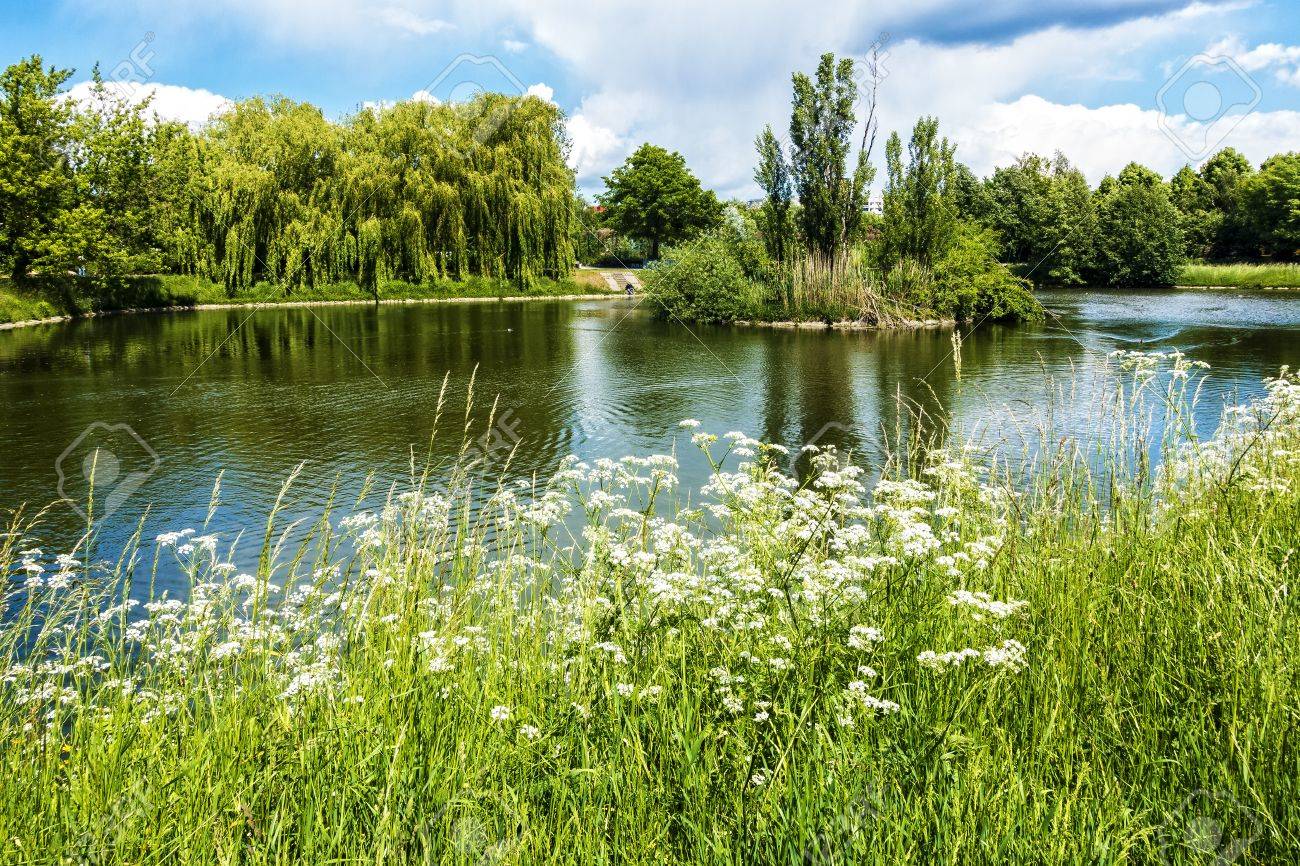
Are you struggling with the health of your lake? Read this to find the best way to harness Mother Nature to look after your lake. With a bit of knowledge, your lake will go from a headache to a haven.
A healthy lake will have clear, clean and neutral smelling water. Take a sample with a clear glass, it should look like tap water, perhaps with a few particles – please don’t drink it though! This healthy lake has lots of different plants around the edges but also within, covering around 1/3rd of the waters surface. These creates lots of habitats for wildlife to live in, creating food from the tiny bugs to the larger birds. Over the lake will be dappled sunlight with invasive weeds such as brambles cut back and treated, and native plants put in their place.
Healthy ponds work under aerobic conditions (presence of oxygen), meaning there is a healthy life cycle taking place in the water. This oxygen might be provided from churning water either naturally or from waterfalls, aerators or fountains. With all this oxygenated water and plants around, there will be lots of Beneficial Bacteria, microscopic bacteria which break down excess nutrients, preventing common issues.
Often aquatic plants are naturally more rampant than garden plants so you are allowed to be tough when cutting back. Lakes need maintaining just as much as your garden but is mostly carried out over the summer until November. Tidy soft stemmed plants as they die to prevent them dropping into the water and rotting, but leave woody stems over the winter as shelter for animals before cutting them back in spring before the new growth. Plants like Elodia and Reeds are very rampant and can cause big issues both for you and if it reaches natural water courses. These are nearly impossible to remove completely but do you best to keep them in check. Be aware with Typha that they can have very deep, strong roots and so if you pull these from clay lined systems, they can cause holes which are expensive to repair – cut them instead.
Excess plant growth can also be caused by too many phosphates in the water. Phosphates are naturally occurring in nature and are essential for the growth of plants. However, decaying plants or water run-off can cause a build up of phosphates in sealed systems such as lakes. When the phosphates become imbalanced, it causes excess plant growth, leading to low oxygen content in the water and a decrease in diversity and habitat destruction.
Healthy ponds work under aerobic conditions (presence of oxygen), meaning there is a healthy life cycle taking place in the water. Excess phosphates can cause excess growth leading to excess death. Beneficial Bacteria consume the decaying organics as they always do, however, this process uses up oxygen within the water. If there is a heavier load of organics to absorb, they are using the waters oxygen faster than it can be added.
This can then lead to anaerobic conditions (absence of oxygen), where different bacteria thrive, releasing toxins into the water as they attempt to absorb the decaying organics. They aren’t as efficient either and so leave partially decomposing organics at the bottom as sludge, adding yet more phosphates to the water, accelerating the process.
Lake Phosphate Binder Packs binds the phosphate into an inaccessible form to prevent it being taken up by plants. It works best in aerobic (oxygen) conditions. This can be achieved with Lake Treatment Booster, or alternative ways of adding oxygen such as aerators, fountains or waterfalls.
Sludge is organic waste from fish, birds, water run off and dying plants. It sinks to the bottom creating that dark slimy soil at the bottom of your lake. Because it is compacted, it is impenetrable to oxygen which means that instead of healthy aerobic conditions (presence of oxygen) where beneficial bacteria can break down the organic materials healthily, anaerobic conditions (absence of oxygen) occur.
This is where different bacteria thrive, releasing toxins into the water as they attempt to absorb the decaying organics. They aren’t as efficient as aerobic bacteria either which is why sludge continues to build up. The bad toxins promote excess growth of plants such as algae, which leads to excess death and an increase of sludge. This is why it’s important to get on top of sludge before it starts speeding up the lifecycles of your pond faster than the Beneficia Bacteria can manage. This can quickly lead to a build up of phosphates as we talked about beforehand.
There are several ways to remove sludge. The quickest but more expensive and intrusive way is by dredging – digging the sludge out. This will also take a lot of bugs and beneficial bacteria with it removing the base of your lake’s food pyramid. This means that you essentially have a brand new pond which will be unstable for the first few years so will need care and attention. There will be a LOT of sludge which needs putting somewhere, often a farmers field or more expensively, carted away. It is good for systems that are too far gone but more gently methods are strongly preferred.
The next way will take longer (sometimes years) but will do it gently and prevent future build ups. To start breaking down the existing sludge, you can use Lake Sludge Remover Packs. These add oxygen to the water, helping the healthy breakdown of organic materials that enter the water. The beneficial bacteria within the water thrive on oxygen and consequently can healthily break down these organics faster. Secondly, Lake Sludge Remover Packs add carbon for proper denitrification. Carbon absorbs the nitrogen from the water which otherwise causes plants to grow well, that’s why we add it to our vegetable patches. The more oxygen you can add to your lake, the healthier it can be.
To keep our lakes clear for the future, we can now look at different methods to prevent this happening again. We can add oxygen to our water through waterfalls, aerators or fountains. Waterfalls work best as they filter out the silt of the running water into an accessible place for easy removal.
We can also add a skimming system to lakes to gently push the water into a designated place. This pushes floating debris into a place we can access easily, before they fall to the bottom, releasing their nutrients.
Filter the water with a Wetland to achieve the Gold Standard of Natural Water Quality. This specially designed filter is filled with Beneficial Bacteria. As the water slowly passes through, they break down the excess nutrients before allowing the water to re-enter the lake.
Find out more about Wetlands, Waterfalls and Lake Management by getting in touch with DU Waterscapes via their Contact Form. You can find this at the bottom of each page.

Aqua Eden, Jordans Courtyard,
Ilminster, TA19 9PY
Open Tue-Fri 10am – 3pm
check social media before travelling for any changes
hello@AquaEden.co.uk
We’re the South West’s newest Water Garden Centre and Design Studio, nestled in the heart of Jordans Courtyard, Ilminster, just off the A303 and J25 of the M5. Whether you’re looking to enhance an existing water feature or create a brand new oasis, we’re here to inspire, educate, and empower you on your water gardening journey. Our friendly, knowledgeable team is passionate about helping you bring your watery dreams to life, and we’re with you every step of the way.
If you’d prefer to leave it to the professionals, our partner company, DU Waterscapes, brings years of experience and expertise to the table. As award-winning water feature artists, they offer expert maintenance and custom installations tailored to your needs. Experience their stunning displays at Aqua Eden and discover how they can bring a slice of Eden to your home. Learn more on their website!